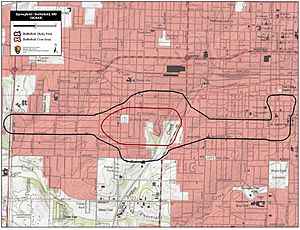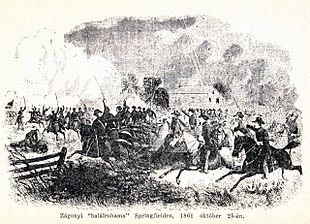Action at Springfield facts for kids
Quick facts for kids Action at Springfield |
|||||||
|---|---|---|---|---|---|---|---|
| Part of the Trans-Mississippi Theater of the American Civil War |
|||||||
 Springfield Battlefield |
|||||||
|
|||||||
| Belligerents | |||||||
| Commanders and leaders | |||||||
| Units involved | |||||||
|
Frémont’s Body-Guard
|
Missouri State Guard | ||||||
| Strength | |||||||
| 326 | 1,000-1,500 | ||||||
| Casualties and losses | |||||||
| 85 | 133 | ||||||
The Action at Springfield, also known as the Battle of First Springfield, was a small but important fight during the American Civil War. It happened on October 25, 1861, in Greene County, Missouri. This battle was special because it was the only time the Union side won a victory in southwestern Missouri during 1861.
Contents
Why the Battle Happened
Union Plans
In 1861, Major General John C. Frémont was in charge of the Union's western army. His main office was in St. Louis. He had a big plan to remove all Confederate soldiers from Missouri. If that went well, he hoped to take the fight into Arkansas and Louisiana.
Frémont's army left St. Louis on October 7, 1861. It grew to more than 20,000 soldiers. About 5,000 of these were cavalry (soldiers who fight on horseback). This group included Maj. Frank J. White's Prairie Scouts and Frémont's Body Guards, led by Major Charles Zagonyi. When Major White got sick, Zagonyi took over both units. These horse-riding soldiers rode ahead of the main army to scout the area.
Confederate Forces Gather
By December, Frémont's army had moved into southwest Missouri. Waiting for them was the main group of pro-Confederate soldiers. These were part of the Missouri State Guard, led by Major General Sterling Price. They were based in Springfield, Missouri.
Price's force was much smaller than Frémont's. Because of this, Price decided to pull his soldiers out of Springfield. Other Missouri State Guard groups nearby tried to join Price's army in Springfield. But they arrived only to find that Price had already left the town.
Who Fought in the Battle
Union Side
- Frémont's Bodyguards: Led by Major Charles Zagonyi
- Major Frank White's Prairie Scouts (also led by Zagonyi during the battle)
Confederate Side
- Missouri State Guard: Led by Colonel Julian Frazier
The Battle of Springfield
As Frémont's army got close to Springfield, the local Confederate leader, Colonel Julian Frazier, asked for more troops from nearby towns. Frémont set up his camp near the Pomme de Terre River. But Zagonyi's scouting group kept going toward Springfield. Colonel Frazier's mixed force of 1,000 to 1,500 soldiers (both foot soldiers and cavalry) got ready to face them.
Zagonyi's group, with 326 men, came towards Springfield on the Mt. Vernon Road. Frazier had planned an ambush (a surprise attack) along this road. Zagonyi then ordered his men to charge from a wooded area near Jordan Creek. He encouraged them by saying, "We have been called holiday warriors...Let the watchword be 'Fremont and the Union!'"
After three charges, the Confederate soldiers ran away in a hurry. Zagonyi's men continued into Springfield. They were cheered by people who supported the Union. They also freed Union prisoners. The soldiers took down the Confederate flag from the courthouse and put up the Union flag. Zagonyi was worried about a Confederate counterattack, so he left Springfield before nightfall. However, Frémont's main army returned a few days later and set up a strong camp in the town.
Soldiers Lost
The Union side reported 15 soldiers killed, 27 wounded, and 10 missing or captured from Frémont's Body Guard. White's command had 33 killed, wounded, or missing. This made a total of 85 Union soldiers lost. The number of Confederate soldiers lost is not fully known, but it is thought to be around 133.
What Happened Next
In the middle of November, Frémont was removed from his command. Major General David Hunter took his place. The Union forces then left Springfield and moved back to Sedalia and Rolla.
However, Union troops came back to Springfield in early 1862. From then on, Springfield was a strong base for the Union side. This small battle was the only Union victory in southwestern Missouri during 1861.


